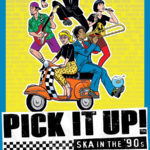The Disability Film Challenge kicks creativity into high gear!

The medium of film in and of itself, without any added qualifiers, self-imposed restrictions or ambitions, is often a complicated trial of chasing equilibrium: Telling a story, making it translate well to an audio/visual means of conveyance, making a statement – either overt or metaphoric – and typically above all, getting one’s film watched by others so the end product can be shared/discussed/reflected upon. Toss constraints of a contest into a film making process and it’s a wonder making something worth watching does not turn into a feat of unbelievably difficult proportions.
Except such pressures are often what bring films to the point where they are as good as they are.
Herein lies much of scenario for those involved in the Disability Film Challenge. The straightforwardness of the competition name against the uniqueness of the people involved with each film submitted presents a dichotomy that begs the challenge be further explored.
A creative endeavor only in its second year, the Disability Film Challenge was conceived by actor, comedian and producer, Nic Novicki. (“The Sopranos,” “Boardwalk Empire” and “Private Practice”). Novicki’s motivation and objective with the DFC was to provide an outlet for filmmaking that empowered actors, producers, directors, those involved in the filmmaking process, to be able to push their individual careers forward, as well as boost “exposure for people with disabilities in the media.”
This is all fine well and good but where exactly is the “challenge” in the Disability Film Challenge?
Here’s the crux of the conditions surrounding the creative environment Novicki designed for films submitted to the Disability Film Challenge:
- Entrants to the challenge are permitted a time slot of 48 hours in which to create their film.
- A specific film theme, which is the same for everyone submitting, along with other story-related stipulations, get sent to entrants and are elements required to be included in the final work.
- Though not an absolute mandate, entrants are highly encouraged to include a disabled person(s), either an actor/actress, director, writer and or producer in the crew.
Novicki’s reasoning behind this contest format is actually rather ingenious –instigating just the right amount of healthy competition while simultaneously driving everyone to turn out their best work:
- The short production time frame will not be a huge commitment to any applicant.
- Deadlines always help young filmmakers finish projects.
- Sponsorship helps spread visibility for entrants.
- Time constraints tend to bring out the creative side in everyone.
Submissions are reviewed by a panel of three judges for three categories: “Best Film,” “Best Film Maker” and “Best Actor.” In addition, there is a peer-controlled fourth category, the “Social Media Award,” that concentrates on which film team can create the most unique campaign for sharing their work and having it recognized by the public via re-posts, likes, commentary and such. (This cateogry has no impact on the former three awards, which are strictly judge-determined.)
“The Kerfuffle” was one film submitted to the challenge this year, which was held between April 17 and April 19, 2015, by a team of seven people. Its playful approach toward this year’s designated romantic comedy theme, as well as the application of the cast’s own disabilities within the short film itself, stirs up plenty of discussion-worthy insights and questions –all without throwing a 10 ton after school special in viewers’ faces to make a point of interest and intrigue around the reality of different disabilities. Check out the film below!
As a side note, even though this aspect of “The Kerfuffle” could not be completed within the timeframe of the contest, the film team is so devoted to what they have made that even with no potential reward attached, an audio description version of the film is in development for the benefit of the blind and visually impaired, thanks to David Linton, a professor of MediaEcology and spoken word poet (often referred to as D.Versified) who has provided the voice for audio descriptions to many documentary/narrative films.
A short film of roughly only three minutes, “The Kerfuffle” centers around the quirky and confusing interactions between three individuals: Samantha, Matt and Jeff. There isn’t much else that can be said beyond that, for fear of spoiling what is a cleverly packaged little film, but, the leading lady who plays Samantha, Dr. M. Leona Godin, shared some of her thoughts on the topic of disability in film, what she feels “The Kerfuffle” offers to its audience and a few of her hopes for the future of the DFC, among some other post-production tidbits!
Kira: Seeing as your film, “The Kerfuffle,” brings together a combination of art, awareness and visibility for people who just happen to live differently abled lives, do tell: How did you come to hear about and get involved with the Disability Film Challenge?
Dr. Godin: Well, about a week before the Challenge David Harrell (our producer and one of my beaus in The Kerfuffle) emailed me to see if I’d like to be a part of his team for a film he was going to make for the Disability Film Challenge, and that’s the first time I heard of it!
One of the rules of the Challenge is that you can’t create any art ahead of the moment you receive the genre/specifics on Friday of the Challenge weekend, but of course what you can do is assemble a cast and crew and hope you can make it work with the peeps yuh got! David mentioned right at the first that the shoot would be 10am-10pm on the Saturday of the challenge, so perhaps that was a deterrent for others. I’ll just pretend I was his first choice!
David and I knew each other through Inclusion in the Arts, an organization which helps disabled artists be represented in the entertainment biz. We had never actually met, but we had spoken over the phone a few times about a project that I was working on for another arts organization, and he had my acting resume and headshot on file since one of the great things about Inclusion in the Arts is that they maintain a database of disabled actors ready for any film/TV/theater or the like to find the real thing! But as to why he thought I might be interested in the first place, we must put to David… perhaps he also watched a couple of my wacky YouTube shenanigans and saw that I’m down for anything?! In any case, I’m glad he asked! I actually really enjoy restrictions and deadlines when it comes to making art. I think it enforces creativity.
Kira: Even if one didn’t know about the assigned rules of Disability Film Challenge, “The Kerfuffle” definitely shows itself to fall quite clearly in what would be a romantic comedy genre classification. Do you think this, as opposed to another film genre, was the “easiest” of story types to tell, given the encouragement to incorporate your and the other actors’ disabilities into the mini-plot? Was there another genre you wish had been assigned instead?
Dr. Godin: After shooting on Saturday night I asked David if he would have preferred another genre, seeing as he seemed to have a few more guys than girls on the team. He gave me an emphatic yes!
I’m not sure what genre I would have preferred—anything else?!–I certainly never considered myself to be the rom com type . I think for my friends it is pretty different from my usual weirdness, though to be sure it still has its fair share of weird!
Honestly, I think having four guys and one girl (Dana who plays Tyler’s date could only come later in the evening) for a romantic comedy made the production team have to get creative. In many ways The Kerfuffle presents a beautiful inversion of the typical plot: Girl meets boys, girl loses boys… oh shit, no spoilers! Anyway, despite all the dudes and the disabilities, this is really a movie about a woman’s fantasy.
Kira: Each individual with a disability has their own line in the sand, so to speak, and discerns their own point of separation between humorously self-reflective and offensive or distasteful. Even though you might be comfortable and familiar with your individual life circumstances, what was the thinking/creating process like when it came time to map out how you would go about blending three different sets of circumstances into a fictional narrative, without risking offense or misinterpretation –either by the future audience or perhaps even among yourselves/the crew?
Dr. Godin: That’s a great question (as are all of these!) Well, David (our producer) definitely wanted to try and make a movie that had disability in it but was not about disability, and I personally think this very premise is what sets our film apart from the other 2015 DFC entries. As the production team (David, Thomas and Kristopher) were brainstorming Friday evening, they thought what if a leg amputee and an arm amputee were dating the same girl?
Nothing but a few slapstick humor bits refer to the disabilities. The plot does not turn on disability issues, but on human issues: desire, romance, and maybe a little greed, all wrapped into a silly tale where the girl and her greediness for all the types was the focus. And by types I mean personality not disability, since Matt is definitely the romantic and Jeff the goofy fun one—that’s why Sam can’t decide between the two of them!
Also, developing distinct characters made the disabilities even more irrelevant I think. And to me, this provides our movie with a very powerful implicit message. We are just silly humans up to our silly human tricks. We have, or do not have, disabilities and just live our lives as ridiculously and/or beautifully as we can.
I will say though that as far as the sight gags are concerned, the first one we shot was me (Samantha) reaching for David’s (Jeff’s) hand and making a face because I don’t find it. For a moment we all paused, wanting to make sure that it read right. It had been a funny thing to think about—reaching for the hand of the armless guy and trying to play footsies with the legless guy, but would it come across? It all moves so fast in the edit that I’m not even sure that an audience catches it the first time round, but in the end, I personally think these are cool moments, not only because they are humorous but also because they highlight the capacity most people have to forget difference if given the right circumstances.
In terms of cast and crew, I can honestly say that our various disabilities were a distant point of concern in the making of the film. Did we have to consider Sommer’s crutches and who would guide me? Sure. But in the midst of the craziness of shooting for twelve hours straight, they were just a couple of logistics amongst hundreds.
Oh right, what exactly is my disability? I’m blind. So I can’t resist mentioning here that as much as my punkity rockity sensibilities shuddered at the idea of playing a leading lady in a rather Sex in the Cityish situation, I loved playing Sam, a role where the blindness is not her defining characteristic. Nowhere in the industry would this be possible at this time. In fact we are still trying to be the ones representing the disabilities let alone playing traditional roles. And I think this is exactly what makes the Disability film Challenge a wonderful opportunity…
When the white cane comes out, it is a moment of complete “I gotta get outta here” dudeness, which is again how the romantic comedy gender roles in The Kerfuffle are truly inverted in so many ways. Sam loves her fantasies and hates conflicts!
Kira: What would be the one thing over all else that you would want everyone who watches “The Kerfuffle” to feel/think/takeaway after viewing it?
Dr. Godin: I think I sort of answered that before and so put this one to the others…
David (Jeff): To me, the biggest thing I would want people taking way from the films is a chuckle! Also, they watch it and think, “Wow, the representation of disability in that film was pretty cool.”
Joshua (Tyler): I would want people to take away that disability should be looked at the way we expressed in this film. As a back burner to everyone’s real story. Sure, it’s there and we recognize it, but it doesn’t make people who they are and what they do.
Kira: This being a platform for sharing what you think, let’s put something out there: For future years of the Disability Film Challenge, who is another actor/actress/director/producer etc. you would wish to see get involved in the project –with the hopes of course, that their reputation in the mainstream film community would help make involvement of disabled in film work to become more commonplace.
Dr. Godin: Well, I hate to be blind-centric here but, what the hell? How often do I get too? The movie that comes to mind to go to for an answer is Red Dragon. Reba is the only blind character in a film I can think of that feels real. That is mainly due, I think, to Thomas Harris’s creation of her, but that is not all. The movie Red Dragon was of course not the only film adaptation of the novel, first there was Manhunter (which is yet another unfortunate adaptation of a novel, but that’s another conversation). But Red Dragon the movie succeeds in portraying blindness (and disability) because, for one thing, Emily Watson does a really good job of being a real person, and a pretty good job of being a blind person too! Also, there are some nice moments of blindness, like Reba searching for mouthwash in d’s (Ralph Fiennes’s) bathroom, her hand trailing along grandma’s jarred teeth. In fact I even mentioned that scene to our director, Thomas Mendolia, when we were filming the bathroom scene. It was the first thing we shot on our twelve hour shoot on Saturday and we were just getting to know each other. (Most of us had met for the first time the night before for a quick run-through of the script.)
So he wanted me to reach for the brush (which was by the way one of the must include props for the challenge) and I said it might be nice for there to be a tiny foreshadow of the blind thing if I were to just run my hand along the shelf for an instant before hitting the brush .
Back to Red Dragon. In many ways, the interaction between Reba and D (the Red Dragon killer who has a speech impediment due to reconstructive surgery on his harelip) is an interaction between two people who have disabilities and their mutual relief at not being treated as freaks on the one hand or like fragile objects on the other.
I guess in the end what I’m saying is that I think Ralph Fiennes should be involved with the Disability Film Challenge because he’s hot!
Kira: Okay, time for a casual bonus inquiry: What’s one blooper that sticks out in your mind that happened during filming?
Dr. Godin: It was near the end of a twelve hour day. We were in the last series of shots that take place in a very romantic setting, candlelight dinner…for three. Samantha’s great friend and roommate Tyler wants to cheer Sam up and thinks it’d be wonderful for her to join him and his girl on their date. Dana (Tyler’s date) had just walked on set and it was her first shot), all is quiet on set while we get adorable footage of Tyler and his date holding hands and looking lovingly into each other’s eyes while Samantha (yours truly) gulps down her cocktail, when an unmistakable exhalation of gas from the lower organs of a certain cast or crew member (who shall remain nameless so as not to ruin his or her career!) rumbles through the quiet for an unbelievable long moment! We, being professionals, hold our giggles till the director calls cut and then all burst out laughing. Then we laughed and laughed.
So you see, disability or no disability, we all fart and we all think it’s hilarious!
“The Kerfuffle” was written and directed by Thomas Mendolia, (with assistant direction by Kristopher Hayes) produced by David Harrell and stars David Harrell, Leona Godin, Sommer Carbuccia, Joshua Giant and Dana Panepinto.
Learn more about the cast and crew through the film’s Facebook page. Viewers of the film are encouraged the share the above video through their social media platforms and help boost visibility with the hashtags, #disabilityfilmchallenge and #thepowertodomore.
Contest aside, sharing/posting/tweeting and otherwise talking about “The Kerfuffle,” or any of the other DFC entrants’ films, serves as a support to the bigger objective of getting the creativity and artistic motivation of everyone who participated, on the screens, and in the minds, of more people out there and that has a value that extends beyond any competition deadline.
Inspired filmmakers and film fans alike can learn more about the Disability Film Challenge at its official website and through these social media outlets:
Facebook
Twitter (@disabilitychall)
YouTube




Leave a Reply